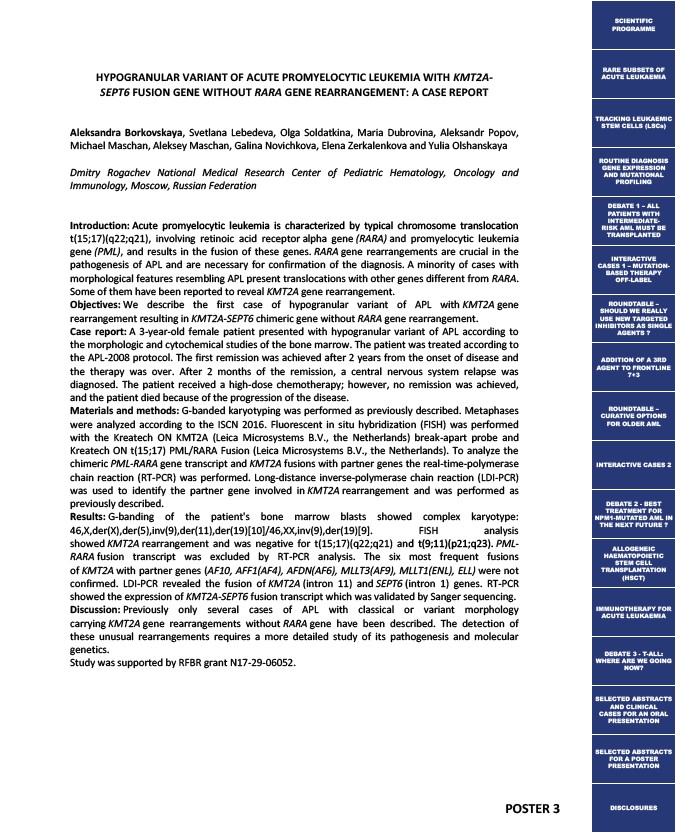
POSTER 3
HYPOGRANULAR VARIANT OF ACUTE PROMYELOCYTIC LEUKEMIA WITH KMT2A-SEPT6
FUSION GENE WITHOUT RARA GENE REARRANGEMENT: A CASE REPORT
Aleksandra Borkovskaya, Svetlana Lebedeva, Olga Soldatkina, Maria Dubrovina, Aleksandr Popov,
Michael Maschan, Aleksey Maschan, Galina Novichkova, Elena Zerkalenkova and Yulia Olshanskaya
Dmitry Rogachev National Medical Research Center of Pediatric Hematology, Oncology and
Immunology, Moscow, Russian Federation
Introduction: Аcute promyelocytic leukemia is characterized by typical chromosome translocation
t(15;17)(q22;q21), involving retinoic acid receptor alpha gene (RARA) and promyelocytic leukemia
gene (PML), and results in the fusion of these genes. RARA gene rearrangements are crucial in the
pathogenesis of APL and are necessary for confirmation of the diagnosis. A minority of cases with
morphological features resembling APL present translocations with other genes different from RARA.
Some of them have been reported to reveal KMT2A gene rearrangement.
Objectives: We describe the first case of hypogranular variant of APL with KMT2A gene
rearrangement resulting in KMT2A-SEPT6 chimeric gene without RARA gene rearrangement.
Case report: A 3-year-old female patient presented with hypogranular variant of APL according to
the morphologic and cytochemical studies of the bone marrow. The patient was treated according to
the APL-2008 protocol. The first remission was achieved after 2 years from the onset of disease and
the therapy was over. After 2 months of the remission, a central nervous system relapse was
diagnosed. The patient received a high-dose chemotherapy; however, no remission was achieved,
and the patient died because of the progression of the disease.
Materials and methods: G-banded karyotyping was performed as previously described. Metaphases
were analyzed according to the ISCN 2016. Fluorescent in situ hybridization (FISH) was performed
with the Kreatech ON KMT2A (Leica Microsystems B.V., the Netherlands) break-apart probe and
Kreatech ON t(15;17) PML/RARA Fusion (Leica Microsystems B.V., the Netherlands). To analyze the
chimeric PML-RARA gene transcript and KMT2A fusions with partner genes the real-time-polymerase
chain reaction (RT-PCR) was performed. Long-distance inverse-polymerase chain reaction (LDI-PCR)
was used to identify the partner gene involved in KMT2A rearrangement and was performed as
previously described.
Results: G-banding of the patient's bone marrow blasts showed complex karyotype:
46,X,der(X),der(5),inv(9),der(11),der(19)10/46,XX,inv(9),der(19)9. FISH analysis
showed KMT2A rearrangement and was negative for t(15;17)(q22;q21) and t(9;11)(р21;q23). PML-RARA
fusion transcript was excluded by RT-PCR analysis. The six most frequent fusions
of KMT2A with partner genes (AF10, AFF1(AF4), AFDN(AF6), MLLT3(AF9), MLLT1(ENL), ELL) were not
confirmed. LDI-PCR revealed the fusion of KMT2A (intron 11) and SEPT6 (intron 1) genes. RT-PCR
showed the expression of KMT2A-SEPT6 fusion transcript which was validated by Sanger sequencing.
Discussion: Previously only several cases of APL with classical or variant morphology
carrying KMT2A gene rearrangements without RARA gene have been described. The detection of
these unusual rearrangements requires a more detailed study of its pathogenesis and molecular
genetics.
Study was supported by RFBR grant N17-29-06052.
SCIENTIFIC
PROGRAMME
RARE SUBSETS OF
ACUTE LEUKAEMIA
TRACKING LEUKAEMIC
STEM CELLS (LSCs)
ROUTINE DIAGNOSIS
GENE EXPRESSION
AND MUTATIONAL
PROFILING
DEBATE 1 – ALL
PATIENTS WITH
INTERMEDIATE-RISK
AML MUST BE
TRANSPLANTED
INTERACTIVE
CASES 1 – MUTATION-BASED
THERAPY
OFF-LABEL
ROUNDTABLE –
SHOULD WE REALLY
USE NEW TARGETED
INHIBITORS AS SINGLE
AGENTS ?
ADDITION OF A 3RD
AGENT TO FRONTLINE
7+3
ROUNDTABLE –
CURATIVE OPTIONS
FOR OLDER AML
INTERACTIVE CASES 2
DEBATE 2 - BEST
TREATMENT FOR
NPM1-MUTATED AML IN
THE NEXT FUTURE ?
ALLOGENEIC
HAEMATOPOIETIC
STEM CELL
TRANSPLANTATION
(HSCT)
IMMUNOTHERAPY FOR
ACUTE LEUKAEMIA
DEBATE 3 - T-ALL:
WHERE ARE WE GOING
NOW?
SELECTED ABSTRACTS
AND CLINICAL
CASES FOR AN ORAL
PRESENTATION
SELECTED ABSTRACTS
FOR A POSTER
PRESENTATION
DISCLOSURES